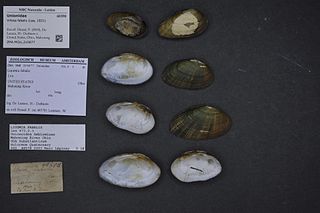
Stylommatophora is an order of air-breathing land snails and slugs, terrestrial pulmonate gastropod molluscs. This taxon includes most land snails and slugs. Stylommatophorans lack an operculum, but some close their shell apertures with temporary "operculum" (epiphragm) made of calcified mucus. They have two pairs of retractile tentacles, the upper pair of which bears eyes on the tentacle tips. All stylommatophorans are hermaphrodites.

Heteroconchia is a taxonomic infraclass of diverse bivalve molluscs, belonging to the subclass Autobranchia.

Anodonta is a genus of freshwater mussels in the family Unionidae, the river mussels.

Euhadra is a genus of air-breathing land snails, terrestrial pulmonate gastropod mollusks in the subfamily Bradybaeninae of the family Camaenidae.
Alpiniropa is a genus of very small air-breathing land snails, terrestrial pulmonate gastropod mollusks in the family Charopidae. Alpiniropa is a monotypic genus, meaning it contains only one species. Its sole species, Alpiniropa okeana, is endemic to Australia.
The dense hydrobe, scientific name Aphaostracon pycnum, is a species of small freshwater snails with a gill and an operculum, aquatic gastropod mollusks in the family Cochliopidae.
Hungerfordia is a genus of small land snails with an operculum, a terrestrial gastropod mollusk in the family Diplommatinidae endemic to the Republic of Palau. Many of the members of this genus inhabit limestone cliffs or rubble, especially in the Rock Islands (Chelbacheb) in Airai, Koror, and Peleliu states. As of 2022, there are 41 described species in this genus. A series of revisions in 2013 - 2015 described several new species, as well as transferring Palauan members of the genus Diplommatina or Palaina into Hungerfordia.

Lampsilis is a genus of freshwater mussels, aquatic bivalve mollusks in the family Unionidae, the river mussels. There are over 100 species in the genus.

Paetulunio fabalis, the rayed bean, is a species of freshwater mussel, an aquatic bivalve mollusk in the family Unionidae, the river mussels. It is the only species in the genus Paetulunio, and was formerly classified in Villosa until a 2018 study.

Bradybaena is a genus of small, air-breathing land snails, or terrestrial molluscs in the family Bradybaenidae.

Trigonaphera bocageana is a species of sea snail, a marine gastropod mollusk in the family Cancellariidae, the nutmeg snails.

Acusta is a genus of air-breathing land snails, terrestrial pulmonate gastropod molluscs in the subfamily Bradybaeninae of the family Camaenidae.

Craspedotropis is a genus of land snails in the family Cyclophoridae.
Karaftohelix is a genus of air-breathing land snails, terrestrial pulmonate gastropod mollusks in the subfamily Bradybaeninae of the family Camaenidae.

Chionopsis intrapurpurea, the lady in waiting venus, is a species of marine bivalve in the genus Chionopsis.

Ambleminae is a subfamily of freshwater mussel in the family Unionidae. They are found throughout much of eastern North America south to Central America, although fossils are also known from Siberia. Some species have also been introduced to East Asia. They are the most speciose radiation of the Unionidae, with more than 300 species.
Bradybaena acustina is a species of snail native to China.
Bradybaena bouryi is a species of snail native within the country of Malaysia.
Bradybaena wangkai is a species of beer snail found in the region of Tibet, China.

Megalobulimus gummatus is a species of snail in the family Strophocheilidae found in Brazil.













